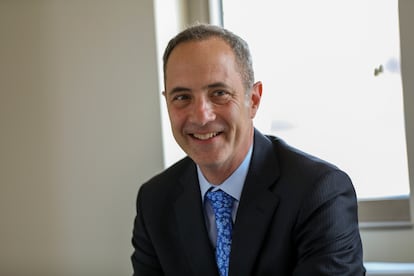Jordan Schwartz, IDB vice president: ‘Latin America will need more infrastructure that protects us from environmental catastrophe’
The Inter-American Development Bank’s executive vice president says construction projects are increasingly having to address both a global public good, like emissions reduction, and a local economic need


Governments in Latin America will have to invest in infrastructure fit for extreme weather while keeping up with fast-advancing technology, says Jordan Schwartz (New Haven, 57), Executive Vice President of the Inter-American Development Bank (IDB). The multilateral bank hosted one of its largest events this week, PPP Americas 2023, which brought together around 500 people in the public and private sectors, to promote public-private partnerships (PPP).
“We used to use the term ‘brick and mortar’ for infrastructure,” Schwartz tells EL PAÍS, during the event at a hotel in Panama City, “but it’s not just brick and mortar now, it’s chips. It’s constant interaction with consumers. This complexity of infrastructure service provision is picking up speed and probably underlying the pressure that we’re seeing from governments.” The bank is the biggest source of development funding for the Latin American region, approving $3 billion for infrastructure last year.
Question. According to the IDB’s own data, Latin America is the region of emerging economies that most have private sector participation in infrastructure. What’s left to do in terms of private public partnerships?
Answer. Since the early 1990s, infrastructure provision in Latin America has worked differently from other middle-income regions. Following the debt crises of the 1980s, there was a wave of privatizations and concessions in ports, water treatment and power plants, and others. When we look at the data going back that far, we see basically an exit of the public sector from the financing of infrastructure. What we’re seeing now is a level of digitalization in almost all of the areas of infrastructure that is new. The new challenge is the level of the technology, the complexity of managing that technology, keeping it up to date and being able to access the information it generates, such as consumption patterns. Buildings are becoming smarter. Roads are being built with sensors to control movement of traffic. We used to use the term “brick and mortar” for infrastructure, but it’s not just brick and mortar now, it’s chips. It’s constant interaction with consumers. This complexity of infrastructure service provision is picking up speed and probably underlying the pressure that we’re seeing from governments to look at ways in which they can bring the private sector into areas they haven’t been brought into before.
Q. Historically, PPPs in Latin America have been mostly used in electrification and roads. What are the sectors that need the most investment now?
A. The region is quite varied. We have huge federated countries with massive geographies. We have island nations. Some are extremely exposed to natural disasters, and some are more protected and stable in their use of natural capital. We have some that are highly urbanized. So each country has its own particular social and economic needs. Having said that, we’re seeing a massive wall of demand of infrastructure that addresses flood management and flood protection, water resource availability and anything pertaining to hydrology. Whether it’s capturing river flow or capturing glacial melt for hydroelectric dams. We also need to include modern approaches to storage and efficiency in the use of turbines because the underlying water resources are diminishing. We’re seeing an increasing need for infrastructure that protects us from environmental catastrophe. This is going to be a theme that we’re going to be confronting more and more as a region.
Q. PPPs face skepticism from the citizenship, after corruption scandals have exposed how they can be abused or misused. How can one guarantee a clean process?
A. Whether it’s PPP, public procurement or contracting, we have to work with our governments to make sure that we’re committed to transparent processes from beginning to end. That’s not just rhetoric, it’s very specific to the competition and the way in which bids are conducted. It refers to the public information that’s available around the primary criteria for selecting firms, the prices that are being paid to contractors, the capacity to audit the engineering of the construction. There is a feature of PPPs that’s different than public contracting, which is that the firm that’s responsible for operating and maintaining the asset over time is part of a consortium that built the asset. So there should be an incentive to build for the duration of what is, traditionally, a long-term contract. That requires a transparent relationship between the public and private sectors and capacity to audit and regulate. And I should mention we have found that the role of the communities where the infrastructure is being built is unequivocally to be central. There is an IDB analysis that looked at projects where there was social stress and large-scale disputes that came about as a result of projects and found that they were more than 60% more expensive in the long run than those that had been able to, either through the nature of the project or through the consultation process, incorporate concerns of communities.
Q. You talked about building for extreme weather, but what about infrastructure for reducing carbon emissions? What are the projects the region needs most?
A. If you had asked this question five years ago, maybe the answer would’ve been that we need to do more to increase the share of renewable energy in the power matrices of the region. Perhaps, secondly, the mention of e-mobility, which refers to the electrification of our transport systems. Those are still really important areas and many of the countries of the region have much to do to advance in these two areas. But what’s interesting about the question is that the issue of emissions and, therefore, of efficiency in the use of energy, has permeated almost all of our projects in recent years. Even road projects. The quality of the asphalt and off-gassing has become a major topic, for example. It is built into specifications of road projects that we are financing. I think we’re going to see efficiency and emission reduction built into an increasing number of projects, particularly those that will rely on, either multilateral development bank financing, or even commercial financing bond financing. Providers of financing looking to demonstrate that they are contributing to sustainable development rather than whatever is the most expedient.
Q. How should a government choose or prioritize which sector to invest in?
A. Often, infrastructure investment is prioritized through non-economic mechanisms of responding to the perception of constituent needs by the people who invariably approve the investments. There has also traditionally been the use of cost-benefit analysis by financiers such as the multilateral development banks, like the IDB, to try to figure out which investments would produce the greatest economic rates of return. Now, governments are turning more and more towards consideration of social and environmental issues in order to prioritize their investments. The methodologies for how to do that are more complex because not everything can be monetized. Biodiversity, for example, can’t really be monetized. We can monetize emissions reduction, but we’d have to give a price to carbon and we haven’t yet all agreed on what the price of carbon should be and we don’t yet have functioning carbon markets. So often those factors require qualitative judgment. Where do we prioritize social impacts? Which social impacts do we prioritize if the government doesn’t have enough money to build everything it wants to build? Which are the social stresses that we want to relieve? The IDB emphasizes access of the poor to the service, the sustainability and the low environmental footprint of the investment, as well as the economic and financial return. We’re addressing, either a global public good, like emissions reduction, or a local public good, like access of a port to service. That’s where the design of the structuring of the project has become more complicated.
Sign up for our weekly newsletter to get more English-language news coverage from EL PAÍS USA Edition
Sobre la firma








































